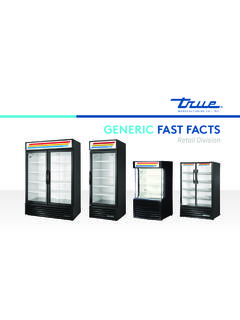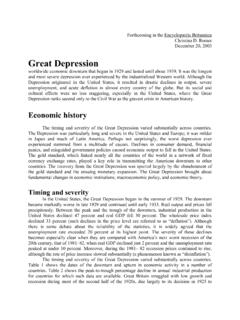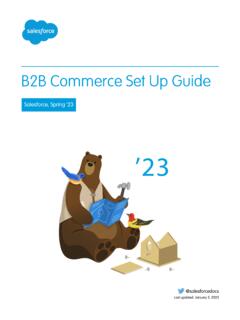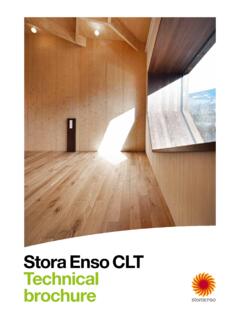Transcription of LEAN ROUTE-TO-MARKET - Four Principles
1 route -TO-MARKET1 Copyright 2017 Four Principles Management Consulting FZ-LLCBACKGROUNDIn general terms a ROUTE-TO-MARKET (RTM) is the way a company brings the right products to the right point of sales at the right time. The RTM is the pipeline through which the company flows goods in one direction (supplier to customer), and the payments generated by them in the opposite direction (customer to supplier). In simple terms, a company could have the best product or service in the world, but it will fail if the company does not put the product or service in front of the right , the RTM core responsibility was to distribute a product from a depot to as many points of sale with a regional or national focus.
2 However, the scope of RTM has expanded to a globalised market with several distribution channels where the market strategy is aligned with the distribution strategy in order to meet the desired product penetration quota and service the defined market niche. Therefore, nowadays excellence in product or service distribution (RTM) depends on the distribution focus and market DISTRIBUTIONS uited for a mass market strategy, with significant volume from several channels with a focus to be in every outlet possible to make the product available to the widest possible consumer DRIVENThe RTM processes are designed market -back to address the customer and consumer RTM platform is aligned and integrated with the company s overall customer service framework (from order processing, to delivery and invoicing).
3 BALANCEDThe RTM framework balances the commitment to meet the main business priorities - customer needs and preferences, revenue growth and DISTRIBUTIONS uited for more specific niche market strategy, with a focus to be in a smaller number of outlets that are frequented by specific and recurrent customers that fit the targeted customer segments, luxury PRACTICE RTM HARMONISES THE NEEDS AND COMPETENCIES OF SALES, MARKETING AND DISTRIBUTION AREAS IN A COMPANY, BOTH INTERNAL AND OUTSOURCED, WHERE THE RELATION IS BASED ON PARTNERSHIP AND SELL-OUT, WHERE THE DISTRIBUTOR ROLE AND RESPONSIBILITY IS CLEARLY DEFINED AND COMMUNICATED, THE GOALS ARE KNOWN AND PURSUED, AND THE REQUIREMENTS FOR AN EFFECTIVE RTM PLATFORM ARE MET:FLEXIBLE AND AGILEThe RTM design is flexible and agile enough to be improved or adjusted based on changing market conditions, the results obtained and the customer s of the development of an increasingly integrated global economy market with very different distribution channels (traditional trade, modern trade, wholesales, on-line trade, etc.)
4 , RTM operations have become the key factor to deliver the right goods, to the right point of sales in the right form, quantity and time, making RTM an excellent candidate for lean solutions that increase quality and lead time while at the same time enabling sustainable cost 2017 Four Principles Management Consulting FZ-LLCCHALLENGESThe biggest challenge for today s CPG (consumer packaged goods) and FMCG (fast moving consumer goods) RTM managers is to enable the brand growth through better sales rates at the lowest possible cost, and hence, profitable growth lean to the RTM operations ensures that companies gain a competitive edge byImproving S&OP processes by setting standardised processes, improving forecasting and demand planning accuracy, managing product mix complexity, managing market seasonality, reducing production variability, integrating different departments into the strategy and tactical plan definition and defining the proper leading and success revenue without sacrificing profit by defining the correct processes to reduce supply chain costs.
5 Improving productivity and customer service without increasing operational costs and reducing operating capital. DEFINING THE CORRECT SOLUTION FOR THE DISTRIBUTION:SELF-OWNEDThe company owns distribution centres and vehicle company outsources distribution centre management and vehicle fleet OUTSOURCEDThe company outsources only parts of the operations, either by distribution channel or type of operations. Managing human resource issues by defining the proper organisation size, roles, responsibilities and making staff effectiveness transparent and quantifiable Enhancing the stock-keeping and stock monitoring capability by implementing the FIFO (first-in-first-out) & FEFO (first-expiry-first-out)
6 Principles , defining robust processes and standardising them across the distribution network Optimisation of resources usage by defining better routing solutions to gain access to remote places without compromising the operating cost and the product viability Managing the constantly increasing complexity of the market by improving flexibility and showing high change-adaptability to know and meet evolving customer demands3 Copyright 2017 Four Principles Management Consulting FZ-LLCFOCUS AREASW aste in RTM processes can be identified, classified and minimised in the same way as waste in manufacturing as well as creating tremendous savings potential.
7 lean Principles , Kaizen methods and re-engineering approaches can be applied in every phase of the supply chain. The right lean solutions can improve product delivery quality, reduce lead-time and reduce working ALL REGIONAL SOCIAL AND CONSUMER TRENDS CHANGING, THE RTM IS FACING A CONSTANT INCREASE OF market COMPLEXITY, PRODUCT COMMODITISATION, TECHNOLOGY INTERFACING AND PRESSURE TO DELIVER A SERVICE DIFFERENTIATION THAT ENGAGES THE COMPANY TO THE market , THEREFORE IDENTIFYING AND CORRECTING THE SEVEN TYPES OF WASTE IS NECESSARY:TRANSPORTATIONU nnecessary transports that result in added cost and lower productivity such as out-of- route stops or excessive returns activity that results in excess inventory or lack thereof - being positioned in a location where needed.
8 An example of this is pushing the product into the distributor or the channel without taking into account the sell-out of the includes any unnecessary movement of people, such as walking, reaching or stretching, due to unoptimised loading layouts or lack of material handling resources, like pallet-jacks, lift trucks or picking lists including out of stock / DELAYP eople, systems and material delays due to badly integrated processes, such as delays of loading and unloading at the distribution depot or at the customer site, sales van queuing in front of sales depot for being loaded / off-loaded due to poorly assigned time windows for sales vans / OVER-PRODUCTIONAny duplicated efforts that may be caused by poorly defined processes or responsibilities between the distributor and the principal, sales van driver is loading the trade shelves himself without following the shelf planogram and later the merchandisers have to adjust the product according to that cause re-work, returns or adjustments, such as.
9 Mislabelled orders delivered at wrong facilities, incorrect documentation or even wrongly balanced loads that result in expired materials in the delivery OF SPACEAny use of space that is less than optimal, accordingly to the measure and route , inefficient van loading planograms or inadequate retail displays 2017 Four Principles Management Consulting FZ-LLCFOCUS AREAS - CONTINUEDLean Solutions designing and implementing lean RTM processes can have a great impact on sales and profit growth. BY APPROACHING THE WASTE FOCUS AREAS MENTIONED ABOVE WITH lean TOOLS, SOME OF THE OPPORTUNITIES THAT COME BY REDUCING LEAD TIMES, INCREASING QUALITY AND REDUCING COSTS IN RTM INCLUDE.
10 Reduction in order handling, loading and unloading time in at the distribution depot or / and the customer site Increased value adding activities and customer face-time Reliability of the information to coordinate demand and supply of goods Reduction in stock variability, stock-outs and excess stock carry-out at the depots, the distribution centres and the customer sites Increased flexibility to approach and subdue ever changing market conditions and clients specifications without needing to spend money to achieve it5 Copyright 2017 Four Principles Management Consulting FZ-LLCLEAN SOLUTIONSWe implement lean Solutions in RTM functions in a similar way to other supply chain solutions.






